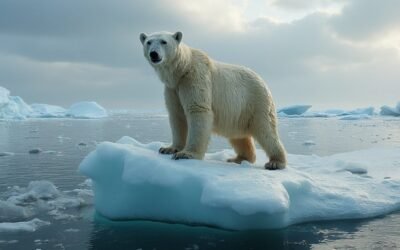In the extreme Arctic tundra, you'll find carnivores like polar bears, Arctic foxes, and wolves expertly maneuvering the harsh conditions. They rely on highly developed senses to locate prey, with polar bears detecting seals nearly a mile away. Thick fur and layers of fat provide essential insulation, while seasonal color changes in species like the Arctic fox serve as effective camouflage. These adaptations are essential for surviving frigid temperatures and scarce food resources. Carnivores play a pivotal role in maintaining the ecological balance by managing prey populations. Discovering how these animals master their environment reveals much about the resilience of nature.
Main Points
- Arctic carnivores have thick fur and fat reserves for insulation against extreme cold.
- Polar bears and foxes use camouflage to blend into snowy environments, aiding in hunting.
- Carnivores like wolves and wolverines employ group hunting or powerful jaws to tackle large prey.
- Many species adapt to winter by selecting strategic shelters or entering hibernation-like states.
- These carnivores maintain ecosystem balance by controlling prey populations and influencing other species interactions.
Winter Hunting Strategies
How do Arctic tundra carnivores manage to hunt effectively in the harsh winter conditions?
In the expansive and snow-blanketed Arctic tundra, carnivores like polar bears, arctic foxes, and wolves have honed their hunting techniques to thrive despite the extreme cold temperatures. They've adapted not just physically, but behaviorally to maximize their survival.
You might find it intriguing that these animals rely heavily on their acute senses of sight, smell, and hearing. These heightened senses are vital for detecting prey in a landscape where visibility is often low, and scents are masked by the cold. For instance, a polar bear's sharp sense of smell allows it to detect seals, its primary prey, from nearly a mile away—even under several feet of solid ice.
Moreover, some carnivores utilize specific hunting strategies that suit their physical capabilities and the nature of their prey. Wolverines, with their robust jaws and claws, can take down much larger animals such as caribou. On the other hand, Arctic wolves use a team-based approach, coordinating with their pack to outmaneuver and hunt down large mammals like muskoxen effectively.
These adaptations ensure these carnivores not only survive but thrive in the challenging winter conditions of the Arctic tundra.
Adaptations to Extreme Cold
To withstand the extreme cold of the Arctic tundra, carnivores have developed several physical and behavioral adaptations. They've grown thick fur and substantial fat reserves to insulate against the biting chill. Their bodies have evolved with smaller extremities to minimize heat loss, keeping their core temperature stable amid freezing conditions.
You'll find that some species, like the Arctic fox, even change color with the seasons. Their fur shifts to white during winter, blending seamlessly with ice and snow. This isn't just for camouflage but also aids in thermal regulation, helping them maintain body heat more effectively. Polar bears, on the other hand, rely heavily on their thick layer of blubber not just for insulation but also as crucial energy storage when food is scarce.
Moreover, these carnivores show special adaptations in behavior. Some might migrate to areas with less severe conditions, while others enter a state akin to hibernation, reducing metabolic rates to conserve energy. Living on the ice floes demands resilience, and these adaptations ensure survival in one of the harshest climates on Earth. You'd see these small mammals leveraging every possible advantage to brave the extreme Arctic cold, illustrating nature's incredible capacity for endurance and adaptability.
Predatory Behaviors and Techniques
In the vast, icy expanse of the Arctic tundra, carnivores such as polar bears and arctic foxes employ stealth and patience to effectively stalk their prey. These predators have honed keen senses of smell, sight, and hearing, which are vital for detecting even the faintest signals of nearby animals. Their ability to remain unseen and unheard until the perfect moment is paramount in a landscape where every advantage counts.
You'll find that polar bears often use ambush hunting techniques, leveraging their white fur to blend seamlessly with the snowy environment. They'll wait motionless for hours, a proof of their patience, until a seal surfaces at a breathing hole. Similarly, arctic foxes, smaller but equally cunning, rely on their sharp senses to locate prey beneath the snow. They pounce through the air to break through the icy crust and catch unsuspecting rodents.
Both of these carnivores possess specialized teeth and powerful jaws, essential for breaking through thick fur and bone. The efficiency of their predatory skills ensures they can thrive in such a demanding habitat, where every meal is hard-won and every calorie counts. Remember, in the Arctic, the survival game is always on, and these carnivores are masters of their craft.
Territory and Shelter Management
Arctic tundra carnivores, such as polar bears and arctic foxes, meticulously manage their territories and create shelters to survive in their harsh environment. You'll find these animals marking boundaries using scent markings or vocalizations, a strategic part of their territory management. This method helps them avoid competition and reduces conflict with other predators, ensuring they've secure access to their essential food sources.
Furthermore, when it comes to shelter selection, these carnivores choose wisely to withstand the harsh weather of the Arctic tundra. They typically opt for snow dens, burrows, or rocky crevices, which offer essential protection from the extreme cold and biting winds. The placement of these shelters is no coincidence; they're often strategically located near abundant food sources. For instance, polar bears might position their dens close to seal breathing holes, while arctic foxes prefer spots near lemming burrows, allowing them easy access to prey without significant energy expenditure.
This careful management of territory and shelter is crucial for their survival, not just providing immediate protection but also conserving energy and maintaining body heat during the critical hibernation periods. Every decision from the location of their shelter to the boundaries of their territory is a calculated move designed to maximize survival in the expansive and unforgiving Arctic tundra.
Interaction With Other Species
While arctic tundra carnivores expertly manage their territories and shelters, their interactions with other species also play a significant role in the ecosystem's dynamics. You'll find these carnivores, including wolves, arctic foxes, and polar bears, at the heart of complex food webs that are important for maintaining balance. They control prey populations, which in turn influences the distribution and behavior of herbivores and other predators.
These carnivores don't just hunt; they also face competition for resources such as food and territory, which can lead to conflicts. This competition is a natural part of life in the harsh tundra, shaping the survival strategies of various species. Additionally, scavengers often rely on the leftovers from these carnivores' meals. Such interactions highlight mutualistic relationships where both scavengers and carnivores benefit.
These dynamics are essential for regulating population numbers within the tundra. Without carnivores to manage these populations, herbivores might overgraze, leading to food shortages and a weakened ecosystem. Therefore, the presence and activities of carnivores help maintain the health and stability of their environment, proving that even in such a remote and rugged landscape, every species is connected, contributing to the overall balance.
Frequently Asked Questions
What Are the Harsh Conditions in the Tundra?
In the tundra, you're facing extreme challenges. You'll deal with low sunlight levels for half the year and a frozen soil layer that's hard to penetrate. The vegetation is sparse, making food scarce, and water sources are limited due to freezing.
The winds are brutally high, exposing you to relentless cold. Plus, the temperature variability is extreme, from bitter cold in winter to brief, mild summers. It's a tough environment to navigate.
What Are the Carnivores in the Arctic Tundra?
In the Arctic tundra, you'll find a variety of carnivores including polar bears, Arctic foxes, wolves, wolverines, snowy owls, and lynx.
Polar bears primarily feed on seals, utilizing sea ice for hunting. Arctic foxes adapt with color-changing fur for camouflage. Wolverines employ diverse hunting strategies, while snowy owls rely on their keen vision to target prey.
Lynx exhibit distinct territorial behaviors, and all these carnivores have unique reproductive cycles adapted to the extreme environment.
What Do Animals in the Tundra Do to Avoid Harsh Winters?
To cope with harsh winters, tundra animals employ several strategies. They develop fat layers for insulation and engage in winter burrowing habits. Some construct snow dens as shelters, while others exhibit shortened activity periods to conserve energy.
Migration patterns are also a key behavioral adaptation, as many species move to warmer areas seasonally. Research into these adaptations helps understand how they survive in such extreme conditions.
What Physical Conditions Make the Tundra a Harsh Biome?
Can you imagine living where the ground is perpetually frozen? In the tundra, you'd face brutal cold, low biodiversity, and permafrost challenges.
Short summers and long, dark winters limit plant growth, leading to nutrient scarcity. This biome offers limited shelter, and you'd also contend with extreme variations in solar radiation.
These conditions make the tundra a harsh environment, testing the resilience of any life form trying to thrive there.
Conclusion
As you've seen, Arctic tundra carnivores exhibit remarkable resilience, adeptly maneuvering through their frigid environment. You might think such extreme conditions would deter these species, but their specialized adaptations and behaviors enable not just survival, but thriving.
Their interactions with other species and strategic resource management showcase an intricate balance of life in one of Earth's harshest climates. Understanding these dynamics helps appreciate the complexity and resilience of Arctic ecosystems, highlighting the importance of their conservation.


